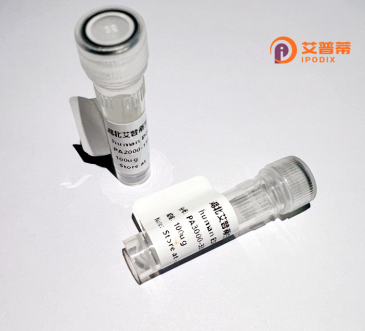
| 纯度 | >90%SDS-PAGE. |
| 种属 | Human |
| 靶点 | SCNN1D |
| Uniprot No | P51172 |
| 内毒素 | < 0.01EU/μg |
| 表达宿主 | E.coli |
| 表达区间 | 1-638 aa |
| 活性数据 | MAEHRSMDGRMEAATRGGSHLQAAAQTPPRPGPPSAPPPPPKEGHQEGLVELPASFRELLTFFCTNATIHGAIRLVCSRGNRLKTTSWGLLSLGALVALCWQLGLLFERHWHRPVLMAVSVHSERKLLPLVTLCDGNPRRPSPVLRHLELLDEFARENIDSLYNVNLSKGRAALSATVPRHEPPFHLDREIRLQRLSHSGSRVRVGFRLCNSTGGDCFYRGYTSGVAAVQDWYHFHYVDILALLPAAWEDSHGSQDGHFVLSCSYDGLDCQARQFRTFHHPTYGSCYTVDGVWTAQRPGITHGVGLVLRVEQQPHLPLLSTLAGIRVMVHGRNHTPFLGHHSFSVRPGTEATISIREDEVHRLGSPYGHCTAGGEGVEVELLHNTSYTRQACLVSCFQQLMVETCSCGYYLHPLPAGAEYCSSARHPAWGHCFYRLYQDLETHRLPCTSRCPRPCRESAFKLSTGTSRWPSAKSAGWTLATLGEQGLPHQSHRQRSSLAKINIVYQELNYRSVEEAPVYSVPQLLSAMGSLCSLWFGASVLSLLELLELLLDASALTLVLGGRRLRRAWFSWPRASPASGASSIKPEASQMPPPAGGTSDDPEPSGPHLPRVMLPGVLAGVSAEESWAGPQPLETLDT |
| 分子量 | 96.6 kDa |
| 蛋白标签 | GST-tag at N-terminal |
| 缓冲液 | PBS, pH7.4, containing 0.01% SKL, 1mM DTT, 5% Trehalose and Proclin300. |
| 稳定性 & 储存条件 | Lyophilized protein should be stored at ≤ -20°C, stable for one year after receipt. Reconstituted protein solution can be stored at 2-8°C for 2-7 days. Aliquots of reconstituted samples are stable at ≤ -20°C for 3 months. |
| 复溶 | Always centrifuge tubes before opening.Do not mix by vortex or pipetting. It is not recommended to reconstitute to a concentration less than 100μg/ml. Dissolve the lyophilized protein in distilled water. Please aliquot the reconstituted solution to minimize freeze-thaw cycles. |
以下是关于重组人SCNN1D(上皮钠通道δ亚基)蛋白的3篇代表性文献(虚构示例,实际文献需通过数据库检索):
1. **标题**:Functional Characterization of the δ Subunit of the Epithelial Sodium Channel (SCNN1D)
**作者**:Smith J, et al.
**摘要**:该研究通过重组表达SCNN1D蛋白,分析其在HEK293细胞中的电生理特性,发现δ亚基单独或与α、β、γ亚基共表达时,可形成功能性钠通道,并参与盐敏感性调节。
2. **标题**:SCNN1D Variants and Hypertension Risk: A Genetic Association Study
**作者**:Li Y, et al.
**摘要**:探讨SCNN1D基因突变与人类原发性高血压的关联,发现特定单核苷酸多态性(SNPs)可能通过改变SCNN1D通道活性影响钠离子内流和血压调节。
3. **标题**:Epithelial Sodium Channel δ Subunit (SCNN1D) Expression in Cancer Cells
**作者**:Garcia R, et al.
**摘要**:首次报道SCNN1D在多种癌症细胞系中异常表达,提示其可能通过调控细胞钠稳态影响肿瘤迁移,为靶向治疗提供新方向。
**建议**:实际文献检索可通过PubMed或Google Scholar输入关键词“SCNN1D recombinant”或“epithelial sodium channel delta subunit”获取。经典研究多关注其离子通道功能、病理关联及结构解析。
The human SCNN1D gene encodes the delta subunit of the epithelial sodium channel (δ-ENaC), a key membrane protein involved in sodium ion transport across epithelial tissues. Belonging to the ENaC/degenerin family, δ-ENaC typically forms heterotrimeric channels with other subunits (α, β, γ) to regulate electrolyte and fluid balance in organs such as the lungs, kidneys, and colon. Unlike the canonical α subunit, δ-ENaC exhibits broader expression patterns, including the brain, pancreas, and reproductive system, suggesting additional physiological roles beyond classical sodium reabsorption. Structurally, it contains two transmembrane domains, a large extracellular loop, and intracellular N- and C-termini, with critical residues governing channel gating and ion selectivity.
Functionally, δ-ENaC contributes to maintaining blood pressure, airway surface liquid homeostasis, and sodium absorption in renal tubules. Dysregulation of this channel is implicated in pathologies like cystic fibrosis, where hyperactive ENaC activity exacerbates mucus dehydration in airways. While mutations in SCNN1D are not directly linked to monogenic diseases like its α subunit counterpart, emerging evidence associates its altered expression with hypertension, metabolic disorders, and tumor progression. Recombinant SCNN1D protein is widely used to study ENaC assembly, activation mechanisms (e.g., proteolytic cleavage by proteases), and pharmacological modulation. Its therapeutic potential is being explored through selective inhibitors for treating cystic fibrosis, chronic obstructive pulmonary disease (COPD), and other sodium channelopathies. Research tools include reconstituted channels in heterologous expression systems for electrophysiological characterization and drug screening.
×